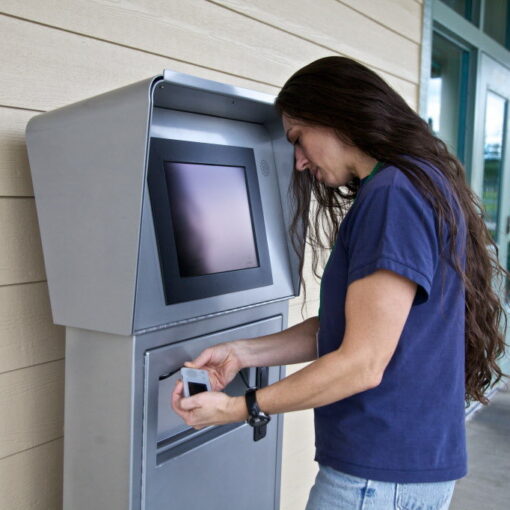 Update (8/9/13): Today the FCC, led by interim Chairwoman Mignon Clyburn, voted to limit how much companies can charge for phone calls from behind bars.
Update (8/9/13): Today the FCC, led by interim Chairwoman Mignon Clyburn, voted to limit how much companies can charge for phone calls from behind bars.
A decade after families of prison inmates asked for action, the Federal Communications Commission voted on a proposal to cap interstate phone rates at 21 cents a minute for debit or prepaid calls and 25 cents a minute for collect calls. Companies wanting to set higher rates would have to file a waiver and could not charge more until that waiver was granted.
Phone rates now fluctuate depending on the provider, the type of call and size of prison facility.
The proposal also calls for requiring the phone service providers to set rates based on their costs. Charges up to 12 cents a minute for debit or prepaid calls and up to 14 cents a minute for collect calls would be considered to be “just and reasonable” rates.
The mechanics of compliance and implementation as well as court challenges to the order will now become the focus of the ICS industry.
It also laid the groundwork for a similair action for intrastate rates…
Statement from the FCC on this vote:
The Federal Communications Commission today took long-overdue steps to ensure that the rates for interstate long-distance calls made by prison inmates are just, reasonable and fair.
Studies make clear that inmates who maintain contact with family and community while in prison have reduced rate of recidivism and are more likely to become productive citizens upon their release. Lower rates of recidivism also benefit society by reducing crime, the need for additional prisons, and other costs.
In addition, an estimated 2.7 million children would benefit from increased communication with an
incarcerated parent. Many of these children face challenges that are manifested in higher rates of truancy,homelessness, depression and other ills.
But the exorbitant price of interstate long-distance calls from correctional facilities today actually
discourages such communication because it is too expensive (over $17 for one 15-minute call),
particularly for families facing economic hardship. The Order takes immediate action to change this and provide an affordable means to encourage such communication.
The Commission’s reforms adopt a simple and balanced approach that protects security and public safety needs, ensures providers receive fair compensation while providing reasonable rates to consumers as follows:
Requires that all interstate inmate calling rates, including ancillary charges, be based on the cost
of providing the inmate calling service
Provides immediate relief to exorbitant rates:
o Adopts an interim rate cap of $0.21 per minute for debit and pre-paid calls and $0.25 per
minute for collect calls, dramatically decreasing rates of over $17 for a 15-minute call to no more than $3.75 or $3.15 a call
o Presumes that rates of $0.12 per minute for debit and prepaid calls ($1.80 for a 15-minute
call) and $0.14 cents per minute for collect calls ($2.10 for a 15-minute call) are just, reasonable and cost-based (safe-harbor rates)
o These rates include the costs of modern security features such as advanced mechanisms
that block calls to victims, witnesses, prosecutors and other prohibited parties; biometric caller verification; real-time recording systems; and monitoring to prevent evasion of restrictions on call-forwarding or three-way calling
Concludes that “site commissions” payments from providers to correctional facilities may not be
included in any interstate rate or charge
Clarifies that inmates or their loved ones who use Telecommunications Relay Services because of
hearing and speech disabilities may not be charged higher rates
Requires a mandatory data collection, annual certification requirement, and enforcement provision to ensure compliance with this Order
Seeks comment on reforming rates and practices affecting calls within a state
Seeks comment on fostering competition to reduce rates
Building on state reforms, the Commission’s action addresses a petition filed nearly a decade ago by Martha Wright, a Washington, D.C. grandmother who sought relief from exorbitant inmate calling rates. Since then, tens of thousands have urged the FCC to make it possible for them to stay in touch with loved ones in jail.
Action by the Commission August 9, 2013, by Report and Order and Further Notice of Proposed
Rulemaking (FCC 13-113). Acting Chairwoman Clyburn and Commissioner Rosenworcel with
Commissioner Pai dissenting. Acting Chairwoman Clyburn, Commissioners Rosenworcel and Pai
issuing statements.
<end of update>
The Federal Communications Commission today said it will propose rules to lower rates charged to prison inmates for long distance telephone calls by considering changes to its regulations governing rates for interstate interexchange inmate calling services (ICS), after studying the issue for nine years. We have printed the key portions of the Proposed Rule Making below.
Given the scope of the request, the high profile parties on both sides of the issue, and the potential negative impact on the revenue of the prison payphone providers and the budgets of state departments of correction; this will be a highly contested rule making. It seems inevitable however that public pressure will force some sort of compromise on the prisons and their inmate communications service providers.
The question then becomes how do the prisons make up the revenue lost through the inevitable reduction in prison phone call commissions? We suggest that they consider deploying the meshDETECT Secure Prison Cell Phone Solutions™ to offset the lost revenue and reduce contraband cell phone smuggling.
There are multiple proposals to address ICS rates in the record. We seek to balance the goal of ensuring reasonable ICS rates for end users with the security concerns and expense inherent to ICS within the statutory guidelines of sections 201(b) and 276 of the Act. Ensuring just and reasonable ICS rates may be accomplished through incentives or regulations, or a combination of both; we seek comment on these proposals below.
A. Rate Caps in the ICS Market
17. In the Alternative Wright Petition, Petitioners requested that the Commission set rate caps for interstate long distance ICS. Specifically, Petitioners requested that the Commission “establish a benchmark rate for domestic interstate interexchange inmate debit calling service of $0.20 per minute and a benchmark rate for domestic interstate interexchange inmate collect calling service of $0.25 per minute, with no set-up or other per-call charge.” The Petitioners used 15 and 20 minute call durations to calculate the rate caps and based their proposed rate caps on then current Federal Bureau of Prison and several individual states’ ICS rates. We seek comment on the elements of the rate cap proposal and whether the criteria used to develop the proposed caps are appropriate.
18. Per-Call Charge. Each time an inmate places a payphone call there are typically two elements that make up its cost – a per-call set up charge and a per-minute charge. We first seek comment on the per-call charge. Petitioners propose eliminating the call set up or per-call charge, which can be as much as $3.95, and allowing only per-minute charges. We seek comment on this proposal. What costs are associated with the per-call charge? Would the elimination of the per-call charge help ensure just and reasonable ICS rates? Would a prohibition on per-call charges result in below-cost service?
19. Petitioners note that inmates often incur multiple per-call charges when calls are dropped after a pause in conversation. We seek data on the average number of dropped calls that inmates experience. We request that commenters suggest ways to prevent multiple per-call charges for a single conversation that is disconnected by security triggers and subsequently allowed to continue while maintaining appropriate security measures. For example, if the per-call charge is maintained, Petitioners suggest that if a disconnected call is reinitiated within two minutes, it should not incur another per-call charge. Should the Commission require such a measure? What other steps could be taken to prevent inmates from being charged multiple per-call charges for what amounts to one conversation? What are the costs associated with call security and are they incurred on a fixed or per-call basis?
20. Per-Minute Rate Caps. Would the per-minute rate cap approach proposed by the Petitioners ensure just and reasonable rates? Are the proposed rate caps just and reasonable consistent with sections 201 and 276 of the Act? If not, would different rate caps be appropriate? What factors should the Commission consider in determining an appropriate per-minute rate cap? Commenters advocating an alternative per-minute rate cap should provide specific, detailed cost information and other relevant data to support their proposed per-minute rate caps. Should the domestic interstate interexchange ICS per-minute rate cap proposed above apply to both publicly- and privately-administered correctional facilities?
21. Some commenters argue that the proposed per-minute rate caps are arbitrary and capricious because they would preclude providers from recovering their legitimate costs of providing service. Others argue that the Alternative Wright Petition proposal is confiscatory or may otherwise put ICS providers out of business. We seek evidence in support of or disproving such arguments. Commenters also argue that the adoption of per-minute rate caps would chill innovation and ultimately result in reductions in service levels because the proposed caps will not adequately compensate the providers, thus making ICS a less attractive service to offer. Others note that new providers are entering the ICS market. Commenters supporting such assertions are asked to provide specific, detailed information about the ICS market to support their positions and describe how market trends influence ICS rates.
22. In the Alternative Wright Petition, Petitioners argue that several benefits would accrue from setting per-minute rate caps, such as administrative ease and the absence of jurisdictional challenges. We seek comment on this argument. Can commenters identify any other benefits to introducing per-minute rate caps? What are the perceived problems or challenges associated with introducing per-minute rate caps? For example, parties argue that differences between correctional facilities including size, location, security levels, facility age and staffing levels will not allow a one size fits all solution, such as per-minute rate caps. Is this accurate? How can the Commission establish a solution that addresses the many variations among confinement facilities?
23. If the Commission decides to implement rate caps in the ICS market how should we? What additional data, if any, does the Commission require to set rates? Would a rate cap approach require the Commission to conduct rate cases, as some commenters suggest? We seek comment on the best ways to determine just and reasonable caps for ICS rates.
24. Marginal Location Methodology. In 2008, ICS providers submitted the ICS Provider Proposal for ICS rates. The ICS Provider Proposal uses the “marginal location” methodology, previously adopted by the Commission to calculate public payphone rates, to calculate proposed ICS rates. The ICS providers believe the “marginal location” methodology provides a “basis for rates that represent ‘fair compensation’ as set forth in § 276(b)(1)(A).” The ICS Provider Proposal advocates a two-part rate structure that includes both a fixed per-call charge and a per-minute rate, arguing that per-call charges must be maintained to cover such expenses as equipment costs and monthly line charges.
The ICS providers determined that the methodology and data yield a requisite fixed per-call charge of $1.56 with a per-minute rate of $0.06 for debit calls, and a fixed per-call charge of $2.49 with a per-minute rate of $0.07 for collect calls, applicable to all ICS providers. In response, Petitioners point out that the ICS Provider Proposal “largely supports Petitioners’ requested benchmark rates.” Petitioners calculate that the ICS Provider Proposal two-part rate structure equals rate caps of $0.16 per minute for a 15-minute debit call and $0.24 per minute for a 15-minute collect call.
25. We seek comment on whether the ICS Provider Proposal methodology would result in a just and reasonable rate. We also encourage commenting parties that disagree with the ICS Provider Proposal or proposed methodology to provide alternative methodologies supported by sufficiently-detailed data. We seek comment on whether the ICS Provider Proposal has provided sufficient cost, demand, and revenue detail to allow the Commission to determine whether the proposed rates are just and reasonable.
26. We also seek comment on whether the underlying cost and demand factors for public payphones and ICS are similar enough to justify using a cost methodology designed for public payphones to set ICS rates. In particular, we seek comment on the extent to which ICS rates and call volumes vary among prisons across the country, and how the rates and call volumes compare with the variation that occurs with public payphones. We seek comment on whether an additional justification exists for adopting this cost methodology.
27. Impact of Rate Reductions on Call Volumes. We seek comment on whether call volumes have increased where rates have been lowered, and the resulting impact on ICS providers’ revenues. We note that the 2011 GAO Report found that only approximately 25 percent of inmates in the Federal Bureau of Prisons use their entire monthly allotted minutes for calls and that if rates were lowered it would encourage greater communications with families, which the Bureau of Prisons “has stated facilitates the reintegration of inmates into society upon release from prison.” Do other correctional facilities find that incarcerated individuals are not using all their allotted time to make calls? How much time is allotted, and what is the percentage of individuals who use all their time?
28. Tiered Pricing. A recent ex parte filing by Petitioners attached a transcript from a New Mexico Public Service Commission hearing that described the possible use of a tiered, by monthly volume of minutes, pricing structure in the state. Do commenters believe a per-minute rate set by usage volume is a viable option? Would tiered pricing address concerns over a one size fits all reform approach such as rate caps? What factors should the Commission consider in establishing pricing tiers? What are potential problems with tiered pricing?
29. Market Forces. Petitioners note that telecommunications costs in general, and long distance costs in particular, are decreasing and therefore, they believe, ICS rates should follow the market and decrease as well. Some participants in this proceeding note that “rates in the largest majority of correctional facilities are moving in a downward trend.” Is this accurate? Can commenters provide concrete examples of decreases in ICS rates?
30. Collect Calling v. Debit Calling. The Alternative Wright Petition suggests two different rate caps: one for collect calling and one for debit calling. A collect call is a call in which the called person pays for the call and a debit call deducts the cost of the call from a prepaid account. Petitioners argue that collect calling is more expensive because its costs include billing costs and uncollectibles, while debit calling is less expensive because it reduces staff responsibilities and uncollectibles. Do commenters agree that there should be different per-minute rate caps for collect and debit calling? What are the benefits of debit calling? For example, do commenters believe that debit calling will exert downward pressure on collect calling rates?
31. Some commenters have expressed concern about the expense and difficulty of implementing debit calling. Specifically, they cite difficulty in blocking restricted telephone numbers, the expense of purchasing new equipment and the challenges of establishing new processes and procedures and verifying calling party identities. Parties have also expressed safety concerns related to debit calling. Some prisons already allow for debit calling. For example, the Federal Bureau of Prisons allows debit calling in some of its facilities and the state of Iowa offers debit calling only. What safety concerns are raised by debit calling service, and how have those concerns been addressed where debit calling already is permitted? Commenters also note the increased administrative workload and cost associated with debit calling caused by such tasks as issuing PINs to each inmate in facilities with high turnover. Have commenters experienced such challenges, and how have they been overcome? What are the other pros or cons of debit calling? We seek comment on ICS providers’ overall experiences with offering debit calling
32. How many correctional facilities currently offer debit calling? Has debit calling become more common? What are the current ratios of debit to collect calling in correctional facilities? Should the Commission mandate debit calling in privately and publicly-administered correctional facilities? One commenter says it offers debit calling to all of the facilities it serves, but it is not practical to mandate debit calling because not all correctional facilities want the service. What are other challenges to mandating debit calling?
33. Prepaid Calling. Commenters suggest prepaid calling as an alternative to collect and debit calling. Prepaid calling allows inmates or their family members to prepay for minutes, usually at a discount. This is different from debit calls, in which money is deducted from an account, but the minutes are not purchased in advance. Commenters argue that the benefits of this approach may include administrative ease for the providers, increased safety, controlled costs for call recipients, and eliminating the need to block calls because of a call recipients’ credit standing. However, Petitioners note that there are outstanding questions with prepaid calling such as: how to handle monthly fees; how to load an inmate’s account; and minimum required account balance. If these issues can be sufficiently addressed, is prepaid calling a viable ICS option? Do any ICS providers currently offer prepaid calling? What are some other concerns or considerations with prepaid calling?
34. Intrastate-Interstate Parity. Another alternative would be to adopt an intrastate-interstate parity principle that would require that rates for interstate, long-distance calls not exceed rates for intrastate, long-distance calls. Rates for intrastate, long-distance calls are typically set by state public utility commissions, and those commissions may set rates that take into account the varying cost of providing inmate calling services within each state given the security and other features required by state law. To the extent that interstate rates for inmate calling services are significantly higher than intrastate rates, how would a requirement that ICS providers set interstate rates at a level no higher than intrastate, long-distance rates affect the justness and reasonableness of those rates? How many states set rates specifically for ICS? What is the rate structure for ICS calls in those states, and what are the rates for intrastate, long-distance calls? How do states that set specific ICS rates ensure that ICS providers are “fairly compensated?” How do intrastate, long-distance rates differ between states that establish general rate caps and those that set specific caps for ICS? If the Commission adopts a parity principle, should there be any exceptions to that principle.
C. Additional Proposals in the Record
35. There are multiple other proposals in the record that do not directly address per-call and per-minute ICS rates. We seek comment on any other proposals parties contend address the concerns raised in this proceeding, including any proposals in the record that are not addressed below.
36. Competition in the ICS Market. The First Wright Petition requested that the Commission mandate the opening of the ICS market to competition and prohibit collect call only restrictions in privately-administered correctional facilities. ICS contracts are typically exclusive; competition appears to exist in winning an ICS contract but once an ICS provider wins a contract it becomes the sole provider. How do exclusive contracts influence ICS rates? How would competitive ICS services be provided? The First Wright Petition also argued that the collect calling-only limitations imposed by many confinement facilities increase costs to both ICS providers and inmates that are not outweighed by corresponding benefits and that such limitations should therefore be prohibited. To the extent ICS is still limited to collect calling in some correctional facilities, we seek comment on the rationale behind this restriction.
37. Site Commissions. ICS contracts frequently include a site commission or location rent which is paid to the facility and in some instances may go to fund inmate services at the facility. What types of inmate services or other services do site commissions fund? How do site commissions in ICS contracts vary by facility? Petitioners argue that ICS rates are inflated to cover commissions, which can be as much as 65 percent of gross revenues, causing the rates to be unreasonable in violation of section 201(b). Is this accurate? We seek updated data on how much these site commissions are and how much they add to per-call costs. The FCC has previously found that “under most contracts, the commission is the single largest component affecting the rates for inmate calling service” and “because the bidder who charges the highest rates can afford to offer the confinement facilities the largest location commissions, the competitive bidding process may result in higher rates.” Do commenters believe this is still accurate? The Commission has also found that “location rents are not a cost of payphones, but should be treated as profit.” Do commenters agree with that conclusion?
38. Some site commissions are mandated by state statute, while several states have reduced or eliminated commissions in ICS contracts. If a state has reduced or eliminated site commissions, how has any resulting rate transition been handled? How has the lowering or elimination of site commissions impacted rates? Is this evidence that site commissions are not necessary, or is it evidence that the market is working and the Commission need not intervene? Must the Commission address site commissions and the effect they have on ICS rates in order to ensure just and reasonable ICS rates?
39. Offer No-Cost Calling. In the Alternative Wright Petition, Petitioners include a suggestion they contend will advance the Commission’s universal service goals and provide all inmates valuable contact with the outside world. Specifically, Petitioners suggest that ICS providers provide a certain amount of no-cost calling per inmate per month in each of the facilities they serve in exchange for the right to charge a higher per-minute rate. Petitioners suggest implementing rate caps of $0.22 per minute for debit calling and $0.275 per minute for collect calling if ICS providers offer 20 minutes of free calling per inmate per month. Can or should the Commission mandate a certain amount of free calling per inmate per month, or should this be offered at the providers’ discretion? What legal questions are raised by this proposal? What other considerations are raised by this proposal?
40. Billing-Related Call Blocking. Petitioners also express concern over billing-related call blocking in correctional facilities. Specifically, Petitioners note that ICS providers are increasingly unable or unwilling to enter into agreements with LECs to provide for ICS providers’ billing the LECs’ customers receiving collect calls from inmates. As a result, ICS providers cannot bill for an increasing percentage of inmate calls and thus “block inmate collect calls to numbers served by LECs with which the service providers have no billing arrangements.” Petitioners argue that in facilities where collect calling is the only option, this practice may ultimately prevent inmates from being able to make any telephone calls. Commenters note that many ICS providers have solutions to “ensure that inmates can contact customers served by these CLECs that refuse to bill for collect calls.” Does this practice continue? Petitioners argue that debit calling, which requires pre-payment, may prevent the need to block calls when the ICS provider does not have a billing arrangement with the terminating LEC. Is this accurate? Do commenters have experience with billing-related call blocking? Can commenters provide data on the average number of calls that are blocked per month and the reason for the blocking? Are there ways, other than mandating debit calling, to deter or prevent billing-related call blocking?
41. Non-Geographic Numbers. ICS providers have argued that lowering interstate calling rates may create an incentive for call recipients to obtain telephone numbers from other states, perhaps from wireless or VoIP providers, to take advantage of the lowered interstate rates. Petitioners counter that the opposite is currently happening; call recipients are obtaining telephone numbers, from wireless or VoIP providers, that are local to the prison to take advantage of lower local calling rates. Have commenters experienced either of these practices? Do these practices raise any security concerns and if so what are those concerns?
42. Disabilities Access. There is evidence in the record to indicate that inmates with hearing disabilities may not have access to ICS at reasonable rates using TTYs. The record suggests that because the average length of a telephone conversation using a TTY is approximately four times longer than a voice telephone conversation, deaf and hard of hearing inmates who use TTYs have to pay more than their hearing counterparts. The record also suggests that TTY users have had to pay additional fees for connecting to a TTY relay operator. We seek comment on the types of ICS access that individuals who are deaf or hard of hearing experience during their incarceration. Where such access to ICS is provided, are the rates the same as those available to those without a disability? If the rates differ, what is that difference and what are the explanations for such difference? We note that section 276(b)(1)(A) specifically exempts “telecommunications relay service calls for hearing disabled individuals” from the Commission-established “per call compensation plan” ensuring that ICS providers are “fairly compensated.” How should the Commission take this exemption into account in examining rates?
43. Updated Data. We seek updated data from all interested parties and the public, but especially from ICS providers. Commenters note that the record regarding nationwide interstate ICS rates is limited to an “analysis of prison phone contracts nationwide” that was conducted by Prison Legal News in April 2011. As such, we seek comment on the accuracy and reliability of the study. In addition, from independent research we have found more-current state rates, which continue to demonstrate a range of prices for ICS calls among states. For example, for a 15-minute interstate call, we found the following rates: $6.65 in California; $2.04 in Montana; $6.45 in Texas; and $16.55 in Idaho. We encourage commenters to submit the most up-to-date information available regarding interstate ICS rates to aid us in developing a clearer understanding of the ICS market. This includes per-call and per-minute rates, information on commissions and what percentage of a rate they comprise, the number of disconnected calls, the average length of calls, and how calls break out by type, i.e., collect, prepaid and debit.
44. We also seek comment on whether the Alternative Wright Petition and ICS Provider Proposal are grounded in sufficiently-reliable data. For example, the ICS Provider Proposal contains data for less than 30 correctional facilities, none of which impose site commissions. Is this too small a sample, or a non-representative sample, on which to base a nationwide solution? ICS providers argue that in calculating their proposed rate caps the Petitioners relied on data from facilities with low cost calling. We therefore invite parties to comment on whether the data supporting the First Wright Petition, the Alternative Wright Petition and the ICS Provider Proposal is representative of correctional facilities across the country.
45. Existing Contracts. Petitioners suggest that if the Commission implements a rate cap it should also mandate a one-year fresh look, transition period for existing ICS contracts Petitioners envision that this transition period would allow for any necessary review and termination or renegotiation of existing ICS contracts in order to introduce rate caps which would be effective by the end of the transition period Commenters argue that the Commission cannot insert itself into the procurement decisions of correctional agencies and that any new ICS-related rules should not be applied to existing contracts but only to contracts entered into after the adoption of new rules
46. Would it be appropriate to mandate a fresh look period or should any new ICS rules apply only to contracts entered into after the adoption of new rules? With renegotiated contracts, how long should the transition period last? What are typical ICS contract terms? Do such contracts usually have change of law provisions that would be triggered by a Commission order? How does the length of existing contracts affect the implementation of any of the proposals discussed above? If commenters provide alternative proposals not discussed above, they should include information on how the contractual process will function with each specific proposal. After implementing a new ICS regime, should the Commission require a periodic rate review to ensure that the rates remain just and reasonable?
47. We encourage comment on any new issues that have arisen in the ICS market or issues that have not been addressed above. We request that commenters provide evidentiary support for their comments and suggestions in this proceeding.
D. Cost/Benefit Analysis of Proposals
48. Acknowledging the potential difficulty of quantifying costs and benefits, we seek to determine whether the proposals above will provide public benefits that outweigh their costs, and we seek to maximize the net benefits to the public from any proposals we adopt. For example, commenters have argued that inmate recidivism is decreased with regular family contact. Accordingly, we seek specific comment on the costs and benefits of the proposals above and any additional proposals received in response to this Notice. We also seek any information or analysis that would help us to quantify these costs or benefits. Further, we seek comment on any considerations regarding the manner in which the proposals could be implemented that would increase the number of people who benefit from them, or otherwise increase their net public benefit. We request that interested parties discuss whether, how and by how much they will be impacted in terms of costs and benefits of the proposals included herein. We recognize that the costs and benefits may vary based on such things as the correctional facility served and ICS provider. We request that parties file specific analysis and facts to support any claims of significant costs or benefits associated with the proposals herein.
- Multi-Blockchain System for Inmate Forensics - April 2, 2024
- Blockchain to Secure Attorney-Inmate Privacy for Prison Calls - June 28, 2023
- meshDETECT® Announces Grant of Ninth Patent For Blockchain Wireless Services - August 26, 2022




